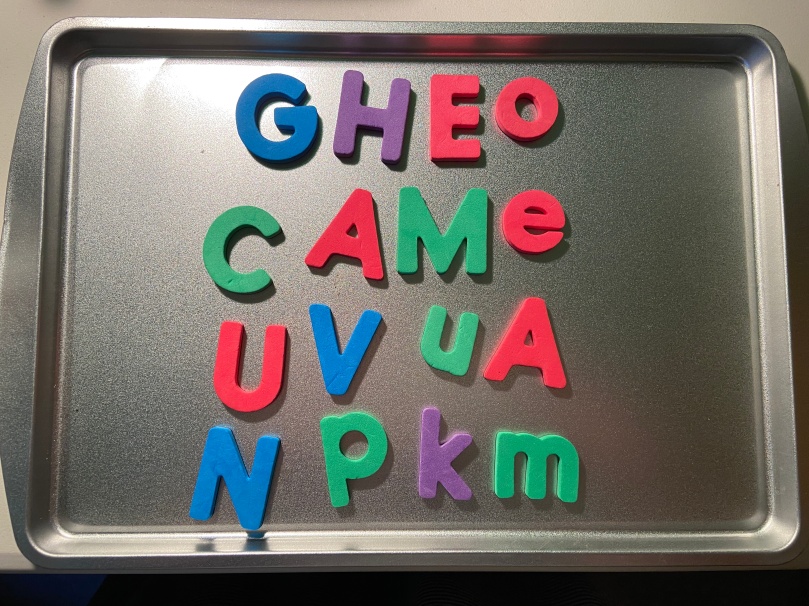
In my opinion, one of the best things about teaching is how generous teachers are with their creativity. I am always on the lookout for new and fun ideas to use in my classroom and have spent many hours scrolling social media, reading blogs, and watching videos to see what others are doing. Sometimes, I learn something new that works in my classroom almost
immediately; other times, an idea goes into my files for another day. Most often, though, I see an idea, think about it, tweak it, and then implement it. It’s not that there was anything wrong with the original idea; it’s just that I know my students, and I like to customize things for our particular learning situation.
Complete the Grid is a game I saw in a YouTube video by Language Teaching Professionals. In the game, you draw a four-by-four grid and label each row and column with a letter. Students then throw something at the board and have to name a word that begins with the y-axis (vertical) letter and ends with the x-axis (horizontal) letter. Language Teaching Professionals states the game is for beginning-level children who are learning English, but I thought it could work with any age. It didn’t take long before I was thinking up variations to the game. Here are some of the more successful ones I’ve come up with:
Materials Variations
Magnetic Complete the Grid

One of the first variations I thought of was to use magnetic letters. Similar to Magnetic Word Search, students randomly choose magnetic letters for the top and side of the game board (made on metal cookie trays using painter’s tape). They then flip a plastic counter or large button onto the board to determine which square they would try to claim.
Tic-Tac-Toe
Another possibility is to use a smaller game grid and play tic-tac-toe. Rather than tossing something or having the square you’re trying to claim semi-randomly determined, students can decide which square to try to claim and, if successful in naming a word with the correct starting and ending letter, claim the square. The final goal also changes from claiming the most squares before the entire grid is filled to claiming three squares in a row.
Velcro Toss
Since throwing things in school is fun, but tossing things at a board and hoping they’ll stick is not always the easiest (or safest) way of doing it, what if the board was made of fabric and the students threw velcro balls? The letters you place on the side can also have velcro on the back, allowing you to quickly and easily change them. You can even enable multiple claims of a square if more than one ball lands in it. Of course, any ball that falls or is knocked to the floor does not count in the final scoring.
Luck of the Roll
The final adjustment I thought of for the game materials is a variation of Cover Up, a popular game in my classes. Give each pair of students a whiteboard and marker and have them draw a four-by-four or three-by-four grid. Then, have them add the letters to the top and side, either the ones you give them or randomly assigned ones. Finally, have them number the grid squares 1-16 or 1-12. At the start of each turn, the active student rolls a die (either d16 or d12) and checks to see if the corresponding square has been claimed yet. If it has, the turn is over. If the square is open, the student tries to claim it by naming a word that starts and ends with the corresponding letters.
Game Rule Variations
Erase and Claim
One way to make the game last a little longer and increase the challenge is to allow students to “steal” squares previously claimed by the other player/team. When a student hits, tosses onto, rolls, or otherwise is “assigned” a square already claimed, he/she can steal it by naming a new word that fits the requirements. If successful, the student can erase or remove the previous student’s claim and place his/her own. A word of warning, though, you may want to limit the number of times a square can be stolen, or the game could go on forever. I usually tell students a square can be claimed and stolen once. After that, if the original owner gets the chance to steal it again, the “ownership” does not revert; the square is a blackout, and no one gets the point. In other words, Player A claims square 7. Later, Player B steals square 7. Still later, Payer A has another opportunity at square 7 and is successful. This time, rather than square 7 reverting to Payer A, it is blacked out (place a black X in it or something similar), and no one gets the point for it.
Adjective Challenge
In this version, students must think of two words. The first word should begin with the y-axis letter and be an adjective that describes the second word, a noun beginning with the x-axis letter. This version provided more of a challenge for my high-intermediate and advanced students.
Theme Words
Another version that challenged my more advanced students was that all words had to be themed. I provided students with the theme (usually the theme of our current unit), and students had to state a word that started and ended with the corresponding letter and matched the theme. If challenged, a student had to be able to provide an explanation for how the word met the theme criteria.
Conclusion
When I tried the original game with my older students, they liked it, but my beginners found it quite challenging to come up with the words. Some of the different modifications helped, while others did not. My advanced students also liked the game, but it wasn’t much of a challenge for them unless they were forced to theme the words somehow. In my opinion, my intermediate students gained the most from the game, and that is who I usually play it with now. What version we play is primarily determined by how much time we have and how far in advance we decide to play. Happy teaching, everyone!
